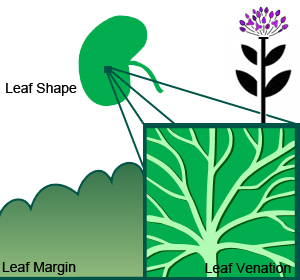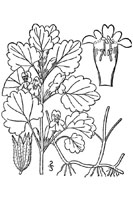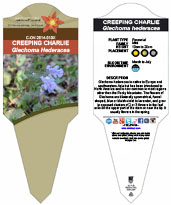Creeping Charlie is an aromatic perennial in the mint family. In geographic areas where many plants lose their leaves, creeping charlie is known as an evergreen creeper due to the fact that the plant stays green throughout all seasons. Creeping Charlie has been known as creeping jenny, but that name more commonly refers to Lysimachia nummularia. European settlers carried creeping charlie seeds around the world, and it has become a well established introduced and naturalized plant in a wide variety of localities.
Creeping Charlie is considered by some to be an attractive garden plant and it is grown in pots and occasionally as a groundcover. Easily cultivated, it grows well in shaded places. A variegated variety is commercially available; in many areas this is the dominant form which has escaped cultivation and become established as an aggressive, adventitious groundcover. Creeping Charlie has numerous medicinal uses, and is used as a salad green in many countries.

Within the realm of naturopathic medicine and folklore, Creeping Charlie has been used in the traditional medicine of Europe dating back thousands of years. Creeping Charlie was used to treat inflammation of the eyes, treat tinnitus, as well as a "diuretic, astringent, tonic and gentle stimulant. Creeping Charlie was also found useful to treat kidney diseases and for indigestion." It has also been used as a "lung herb". Other traditional uses include as an expectorant, astringent, and to treat bronchitis. The essential oil of the plant has been used for centuries as a general tonic for colds and coughs, and to relieve congestion of the mucous membranes. In the traditional Austrian medicine the herb has been prescribed for internal application as salad or tea for the treatment of variety of different conditions including disorders associated with the liver and bile, gastrointestinal tract, respiratory tract, kidneys and urinary tract, fever, and flu. Creeping Charlie was also widely used by the Saxons in brewing beer as flavouring, clarification, and preservative, before the introduction of hops for these purposes; thus the brewing-related names, alehoof, tunhoof, and gill-over-the-ground as synonyms for creeping charlie. Creeping Charlie has been known to be used in the cheese-making process as a substitute for animal rennet.
Please note that MIROFOSS does not suggest in any way that plants should be used in place of proper medical and psychological care. This information is provided here as a reference only.
The fresh herb can be rinsed and steeped in hot water to create an herbal tea which is rich in vitamin C. It has a distinctive, mild pepper-like flavour; it can be cooked as a pot herb, although it is most commonly eaten as a fresh salad green.

Creeping Charlie can be identified by its round to reniform (kidney or fan shaped), crenate (with round toothed edges) opposed leaves 2–3 cm diameter, on 3–6 cm long petioles attached to square stems which root at the nodes. It is a variable species, its size being influenced by environmental conditions, from 5 cm up to 50 cm tall. Creeping Charlie flowers are bilaterally symmetrical, funnel shaped, blue or bluish-violet to lavender, and grow in opposed clusters of 2 or 3 flowers in the leaf axils on the upper part of the stem or near the tip. It usually flowers in the spring. Creeping Charlie flowers are hermaphrodite (have both male and female organs) and are pollinated by Bees.It is noted for attracting wildlife. Creeping Charlie is sometimes confused with common mallow (Malva neglecta), which also has round, lobed leaves; but mallow leaves are attached to the stem at the back of a rounded leaf, where ground ivy has square stems and leaves which are attached in the centre of the leaf, more prominent rounded lobes on their edges, attach to the stems in an opposite arrangement, and have a hairy upper surface. In addition, mallow and other creeping plants sometimes confused with ground ivy do not spread from nodes on stems. In addition, ground ivy emits a distinctive odour when damaged, being a member of the mint family. Creeping Charlie spreads by stolons or by seed. Part of the reason for its wide spread is this rhizomatous method of reproduction.
| Plant Height |
10cm to 50cm |
| Habitat |
Roadsides, Fields, Lawns |
| Leaves |
Reniform, kidney shaped, 1.5cm to 4cm long |
 |
| Leaf Margin |
Crenate |
| Leaf Venation |
Palmately lobed |
| Stems |
creeping stems up to 2m long |
| Flowering Season |
March to July |
| Flower Type |
Rounded clusters of 1.5cm to 2cm long flowers with 2 lips, 3 lobes, and 4 stamens |
| Flower Colour |
violet-blue |
| Pollination |
Insect |
| Flower Gender |
Flowers are hermaphrodite and the plants are self-fertile |
| Fruit |
Small round seeds |
| USDA Zone |
3A (-37.3°C to 39.9°C) cold weather limit |
The following health hazards should be noted when handling or choosing a location to plant creeping charlie:
 |
ENVIRONMENTAL HAZARD
Creeping Charlie is toxic to cattle and horses.
|
 |
-Click here- or on the thumbnail image to see an artist rendering, from The United States Department of Agriculture, of creeping charlie. (This image will open in a new browser tab) |
 |
-Click here- or on the thumbnail image to see a magnified view, from The United States Department of Agriculture, of the seeds created by creeping charlie for propagation. (This image will open in a new browser tab) |
Creeping Charlie can be referenced in certain current and historical texts under the following seven names:
Bull Thistle can be translated into the following select languages:
| Arabic |
الزاحف تشارلي |
Bulgarian |
Пълзяща Чарли |
Chinese (Sim) |
匍匐查理 |
| Croatian |
puzanje Charlie |
Czech |
mateřídouška Charlieho |
Danish |
krybende Charlie |
| Dutch |
|
Esperanto |
|
Estonian |
hiiliv charlie |
| Finnish |
|
French |
|
German |
|
| Greek |
υφέρπουσες Τσάρλι |
Hebrew |
זוחל charlie |
Hungarian |
kúszó charlie |
| Italian |
|
Japanese |
チャーリー忍び寄る |
Korean |
찰리 들어온다 |
| Low Saxon |
|
Lithuanian |
Baltosios Charlie |
Norwegian |
|
| Persian |
در حال اجرا چارلی |
Polish |
|
Portuguese |
|
| Romanian |
|
Russian |
Ползучая Чарли |
Slovak |
Materina dúška Charlieho |
| Spanish |
|
Swedish |
|
Tagalog |
gumagapang Charlie |
| Turkish |
charlie sürünen |
Ukrainian |
повзуча Чарлі |
Vietnamese |
|
| The information provided in this conservation assessment has been provided by the Natureserve Database in conjuction with various federal, provincial, state, county, district, regional, and municipal governments as well as public and private conservation authorities. Information in this section is accurate from the last time this article was updated. |
 |
Creeping Charlie has no conservation status as it is considered an exotic and or invasive species in North America. |
 |
The MIROFOSS database offers free printable garden tags for personal and non-profit use. These tags can be used to properly identify plant samples in a garden. Click on the tags shown on the the screen or -click here- to download a full size jpeg image for an creeping charlie identification tag; which can be printed on paper or used with a plastic laser printer. |
 |
What's this?
This is a QR code (short for Quick Response) which gives fast-track access to MIROFOSS articles. QR Codes are barcodes that can be read by smart phone cameras. This QR Code is unique to this MIROFOSS article.
What can I do with it?
You can copy and print the QR code to a plant label, poster, book, web site, magazines, or newspaper so smart phone users can scan the QR Code which automatically takes them to this specific article.
|

| Description |
"GROUND IVY: Glechoma hederacea". Ohio Perennial & Biennial Weed Guide. Ohio Agricultural Research and Development Center, Ohio State University. |
| Folklore |
Vogl S, Picker P, Mihaly-Bison J, Fakhrudin N, Atanasov AG, Heiss EH, Wawrosch C, Reznicek G, Dirsch VM, Saukel J, Kopp B. Ethnopharmacological in vitro studies on Austria's folk medicine - An unexplored lore in vitro anti-inflammatory activities of 71 Austrian traditional herbal drugs. J Ethnopharmacol.2013 Jun13. doi:pii: S0378-8741(13)00410-8. 10.1016/j.jep.2013.06.007. |
| Biology |
Joanne Barnes, Linda A. Anderson, J. David Phillipson, Herbal Medicines, 2nd ed., Pharmaceutical Press, London, 2002. |
| Biology |
An HJ, Jeong HJ, Um JY, Kim HM, Hong SH. "Glechoma hederacea inhibits inflammatory mediator release in IFN-gamma and LPS-stimulated mouse peritoneal macrophages"; Journal of Ethnopharmacology: Vol. 106, No. 3, pg. 418-24, 2006 |
| Image Rendering |
USDA-NRCS PLANTS Database / USDA NRCS. Wetland flora: Field office illustrated guide to plant species. USDA Natural Resources Conservation Service. |
| Environment |
National Audubon Society. Field Guide To Wildflowers (Eastern Region): Alfred A. Knopf. pp 415-420 ISBN 0-375-40232-2 |
| Physical Identification |
National Audubon Society. Field Guide To Wildflowers (Eastern Region): Alfred A. Knopf. pp 415-420 ISBN 0-375-40232-2 |
| February 20, 2015 |
The last time this page was updated |
| ©2021 MIROFOSS™ Foundation |
 |
|
|




















